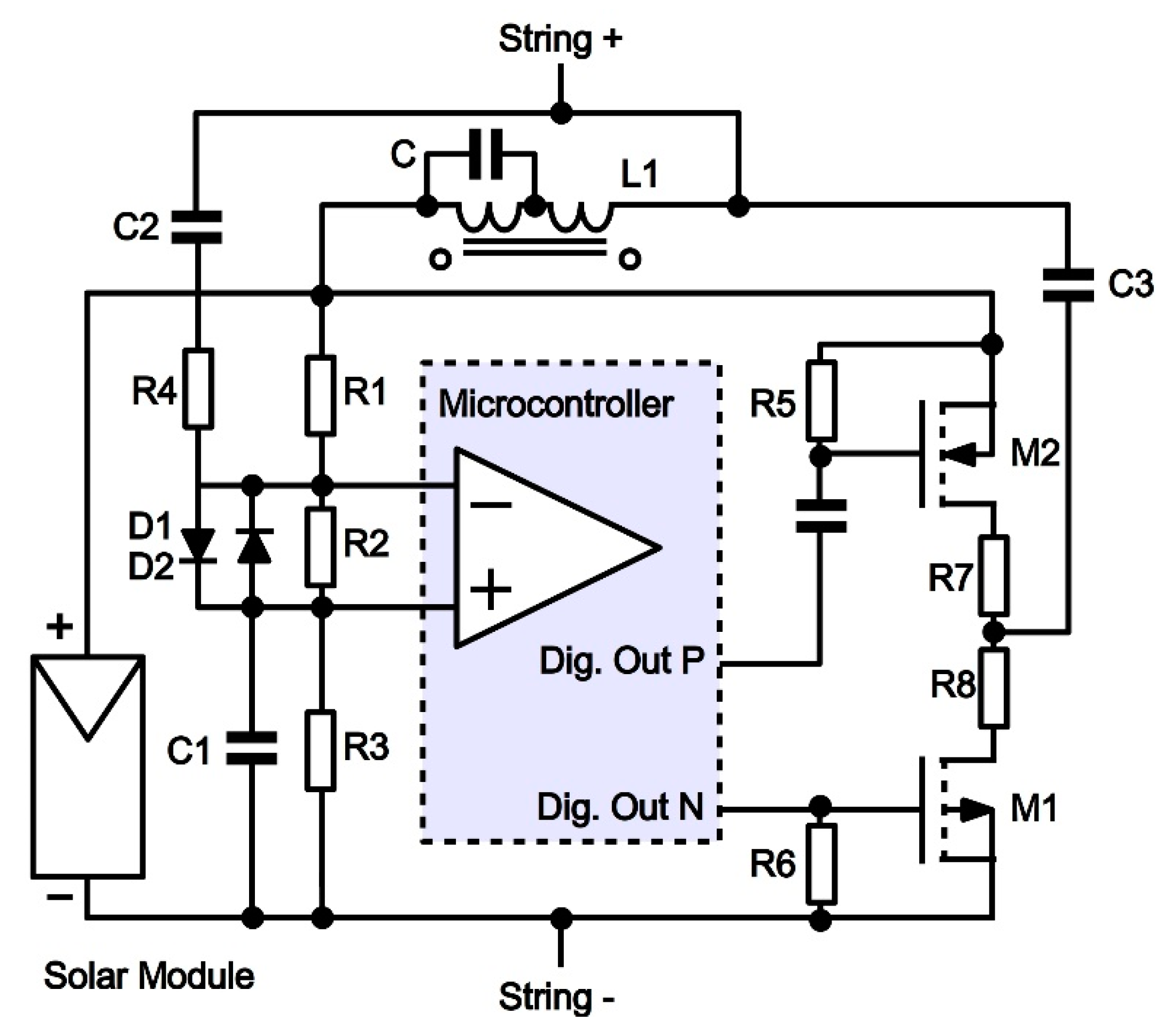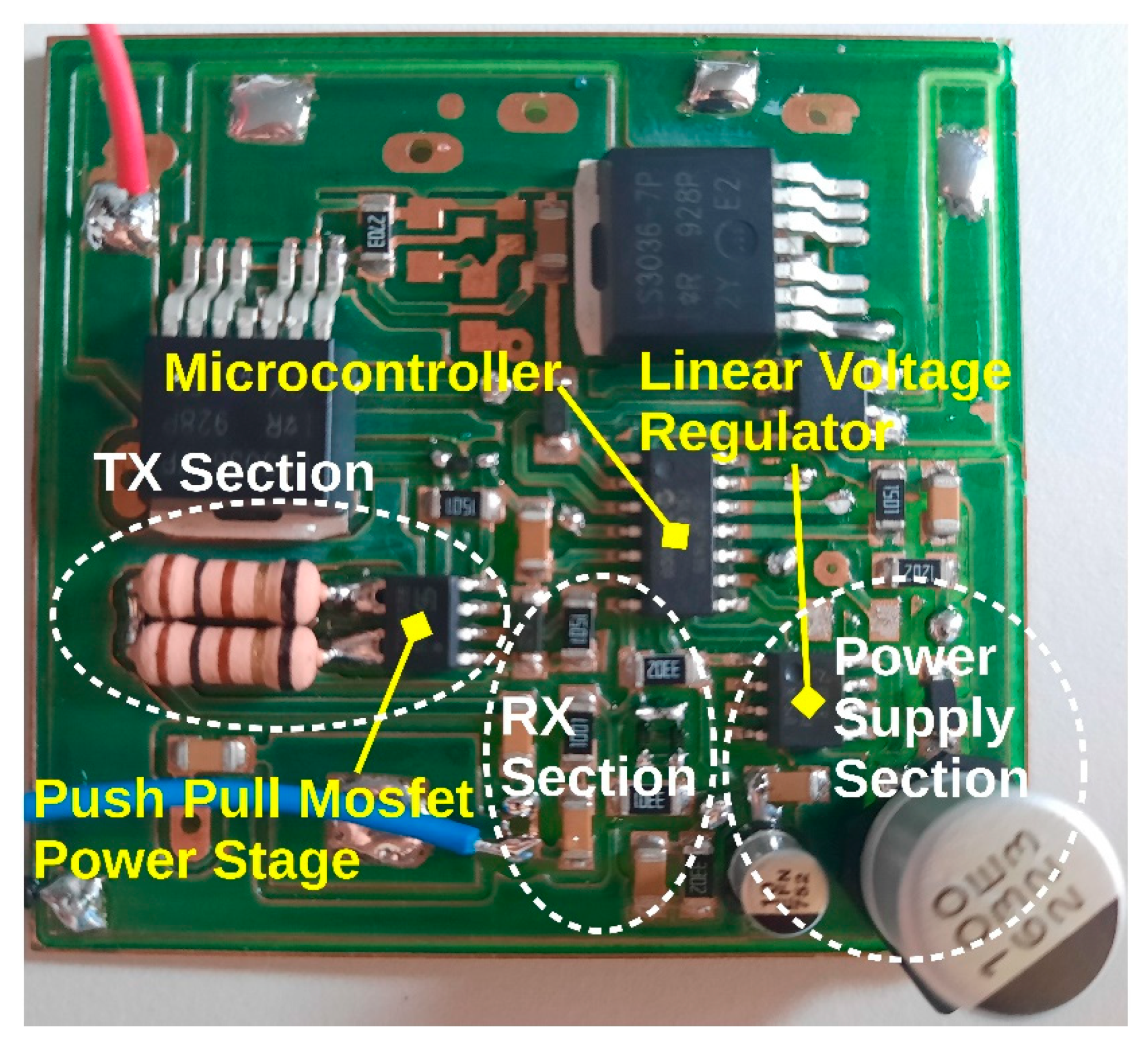A Power-Line Communication System Governed by Loop Resonance for Photovoltaic Plant Monitoring
Abstract
1. Introduction
2. Materials and Methods
2.1. Loop Resonance
2.2. Coil Saturation
2.3. Electronics Designed
3. Results
4. Discussion
5. Conclusions
Author Contributions
Funding
Institutional Review Board Statement
Informed Consent Statement
Data Availability Statement
Acknowledgments
Conflicts of Interest
References
- Irena. Renewable Power Generation Costs 2020. 2021. Available online: www.irena.org (accessed on 10 March 2022).
- Köntges, M.; Kurtz, S.; Packard, C.; Jahn, U.; Berger, K.A.; Kato, K. Performance and reliability of photovoltaic systems subtask 3.2: Review of failures of photovoltaic modules. In IEA PVPS Task 13: External Final Report IEA-PVPS; International Energy Agency: Paris, France, 2014. [Google Scholar]
- Triki-Lahiani, A.; Abdelghani, A.B.-B.; Slama-Belkhodja, I. Fault detection and monitoring systems for photovoltaic installations: A review. Renew. Sustain. Energy Rev. 2018, 82, 2680–2692. [Google Scholar] [CrossRef]
- Morales-Aragonés, J.; Gallardo-Saavedra, S.; Alonso-Gómez, V.; Sánchez-Pacheco, F.; González, M.; Martínez, O.; Muñoz-García, M.; Alonso-García, M.; Hernández-Callejo, L. Low-Cost Electronics for Online I-V Tracing at Photovoltaic Module Level: Development of Two Strategies and Comparison between Them. Electronics 2021, 10, 671. [Google Scholar] [CrossRef]
- Han, J.; Choi, C.-S.; Park, W.-K.; Lee, I.; Kim, S.-H. PLC-based photovoltaic system management for smart home energy management system. IEEE Trans. Consum. Electron. 2014, 60, 184–189. [Google Scholar] [CrossRef]
- Di Napoli, F.; Guerriero, P.; D’Alessandro, V.; Daliento, S. A Power Line Communication on DC Bus with Photovoltaic Strings; IET: London, UK, 2014. [Google Scholar] [CrossRef]
- Ochiai, H.; Ikegami, H. PPLC-PV: A pulse power line communication for series-connected PV monitoring. In Proceedings of the 2016 IEEE International Conference on Smart Grid Communications, SmartGridComm 2016, Sydney, Australia, 6–9 November 2016; pp. 338–344. [Google Scholar] [CrossRef]
- Sanchez-Pacheco, F.J.; Sotorrio-Ruiz, P.J.; Heredia-Larrubia, J.R.; Perez-Hidalgo, F.; de Cardona, M.S. PLC-Based PV Plants Smart Monitoring System: Field Measurements and Uncertainty Estimation. IEEE Trans. Instrum. Meas. 2014, 63, 2215–2222. [Google Scholar] [CrossRef]
- Han, J.; Lee, I.; Kim, S.-H. User-friendly monitoring system for residential PV system based on low-cost power line communication. IEEE Trans. Consum. Electron. 2015, 61, 175–180. [Google Scholar] [CrossRef]
- Ma, S.-D.; Park, M.-S.; Kim, J.-E. DC-PLC Modem design for PV module monitoring. J. Int. Counc. Electr. Eng. 2016, 6, 171–181. [Google Scholar] [CrossRef][Green Version]
- Han, J.; Jeong, J.-D.; Lee, I.; Kim, S.-H. Low-cost monitoring of photovoltaic systems at panel level in residential homes based on power line communication. IEEE Trans. Consum. Electron. 2017, 63, 435–441. [Google Scholar] [CrossRef]
- Mao, W.; Zhang, X.; Cao, R.; Wang, F.; Zhao, T.; Xu, L. A Research on Power Line Communication Based on Parallel Resonant Coupling Technology in PV Module Monitoring. IEEE Trans. Ind. Electron. 2017, 65, 2653–2662. [Google Scholar] [CrossRef]
- Zhu, Y.; Wu, J.; Wang, R.; Lin, Z.; He, X. Embedding Power Line Communication in Photovoltaic Optimizer by Modulating Data in Power Control Loop. IEEE Trans. Ind. Electron. 2018, 66, 3948–3958. [Google Scholar] [CrossRef]
- Daldal, N.; Uzun, B.; Bekiroglu, E. Measurement and Evaluation of Solar Panel Data Via DC Power Line. In Proceedings of the 10th International Conference on Smart Grid, icSmartGrid 2022, Istanbul, Turkey, 27–29 June 2022; pp. 280–284. [Google Scholar] [CrossRef]
- Aljafari, B.; Madeti, S.R.K.; Satpathy, P.R.; Thanikanti, S.B.; Ayodele, B.V. Automatic Monitoring System for Online Module-Level Fault Detection in Grid-Tied Photovoltaic Plants. Energies 2022, 15, 7789. [Google Scholar] [CrossRef]
- Morales-Aragonés, J.I.; Williams, M.S.M.; Gómez, V.A.; Gallardo-Saavedra, S.; Redondo-Plaza, A.; Fernández-Martínez, D.; Sánchez-Pacheco, F.J.; Cuadro, J.G.F.; Hernández-Callejo, L. A Resonant Ring Topology Approach to Power Line Communication Systems within Photovoltaic Plants. Appl. Sci. 2022, 12, 7973. [Google Scholar] [CrossRef]




| Parameters | Value | Units |
|---|---|---|
| Max TX speed 1 | 143 | kbps |
| Bit Error Rate (BER) at max. speed | 3 × 10−3 | - |
| Noise to Carrier Ratio (NCR) 2 | 31 | dB |
| Inter Symbol Interference (ISI) 3 | 2 | us |
| Energy consumption by bit = 1 transmitted 1,4 | 4 × 10−10 | Wh |
| Energy consumption by bit = 0 transmitted 1,4 | 1 × 10−10 | Wh |
| Author | Cost per PV Module | Carrier Frequency | Bitrate |
|---|---|---|---|
| Napoli et al. [6] | 30 Eur | 132.5 KHz | n/a |
| Ochiai et al. [7] | >25 Eur (*) | 1 KHz | n/a |
| Sanchez et al. [8] | 10 Eur | 100 KHz | n/a |
| Han et al. [5,9] | >25 Eur (*) | 2–30 MHz | 4 Mbps |
| Mao et al. [12] | 5 Eur (**) | 200 KHz | 10 Kbps |
| Daldal et al. [14] | >70 Eur (*) | n/a | n/a |
| Proposed method | 12 Eur | 1 MHz | 200 Kbps |
Publisher’s Note: MDPI stays neutral with regard to jurisdictional claims in published maps and institutional affiliations. |
© 2022 by the authors. Licensee MDPI, Basel, Switzerland. This article is an open access article distributed under the terms and conditions of the Creative Commons Attribution (CC BY) license (https://creativecommons.org/licenses/by/4.0/).
Share and Cite
Morales-Aragones, J.I.; Williams, M.S.M.; Kupolati, H.; Alonso-Gómez, V.; Gallardo-Saavedra, S.; Redondo-Plaza, A.; Muñoz-García, M.Á.; Sánchez-Pacheco, F.J.; Hernández-Callejo, L. A Power-Line Communication System Governed by Loop Resonance for Photovoltaic Plant Monitoring. Sensors 2022, 22, 9207. https://doi.org/10.3390/s22239207
Morales-Aragones JI, Williams MSM, Kupolati H, Alonso-Gómez V, Gallardo-Saavedra S, Redondo-Plaza A, Muñoz-García MÁ, Sánchez-Pacheco FJ, Hernández-Callejo L. A Power-Line Communication System Governed by Loop Resonance for Photovoltaic Plant Monitoring. Sensors. 2022; 22(23):9207. https://doi.org/10.3390/s22239207
Chicago/Turabian StyleMorales-Aragones, José Ignacio, Matthew St. Michael Williams, Halleluyah Kupolati, Víctor Alonso-Gómez, Sara Gallardo-Saavedra, Alberto Redondo-Plaza, Miguel Ángel Muñoz-García, Francisco José Sánchez-Pacheco, and Luis Hernández-Callejo. 2022. "A Power-Line Communication System Governed by Loop Resonance for Photovoltaic Plant Monitoring" Sensors 22, no. 23: 9207. https://doi.org/10.3390/s22239207
APA StyleMorales-Aragones, J. I., Williams, M. S. M., Kupolati, H., Alonso-Gómez, V., Gallardo-Saavedra, S., Redondo-Plaza, A., Muñoz-García, M. Á., Sánchez-Pacheco, F. J., & Hernández-Callejo, L. (2022). A Power-Line Communication System Governed by Loop Resonance for Photovoltaic Plant Monitoring. Sensors, 22(23), 9207. https://doi.org/10.3390/s22239207










